|
|
 |
|
April 29, 2011
News that Jess Jackson had died shortly before Easter at the age of 81 hardly came as a surprise. It was well known that Jackson, a giant in the California wine industry, had been battling cancer.
What is difficult to fathom is that this lion of California wine would succumb to anything. I didn't know him well, but I knew him well enough to know that Jackson was among the most determined vintners of our time.
.jpg) Jess Stonestreet Jackson was a native of San Francisco and a practicing attorney when he founded Kendall-Jackson winery in Lakeport, Calif., in 1982. That would be in Lake County, well north of the Napa Valley, and hardly the place you would expect to discover a budding wine dynasty. Jess Stonestreet Jackson was a native of San Francisco and a practicing attorney when he founded Kendall-Jackson winery in Lakeport, Calif., in 1982. That would be in Lake County, well north of the Napa Valley, and hardly the place you would expect to discover a budding wine dynasty.
Some would argue that Kendall-Jackson rode the Chardonnay wave of the early 1980s to fame and fortune. Others would say that K-J started the wave, which continues to this day, for Chardonnay is the most widely sold and consumed white wine in America. No matter how you view it, Kendall-Jackson and the ubiquitous "Vintner's Reserve" Chardonnay launched what became the vast Jess Jackson wine empire.
The world learned two things about Jackson from his Vintner's Reserve Chardonnay: he was a marketing genius and knew what consumers wanted.
From a marketing standpoint, the term Vintner's Reserve was controversial, since the wines were produced in prodigious volumes and anything but "reserve." The Vintner's Reserve Chardonnay also had a secret that was eventually outed during a contentious lawsuit involving a former K-J winemaker: The Chardonnay was slightly sweet, with a level of residual sugar that was higher than the industry standard at that time for a dry table wine.
Jackson knew that American consumers talked dry wine, but they had slightly sweeter tastes than they were willing to admit. Others imitated the K-J style, and Chardonnay sales skyrocketed at a time when consumers were just beginning to drink varietally labeled wines. It was a bygone era when most restaurants offered a white and a red house wine; no one ever asked for a glass of Chardonnay. That was prior to K-J.
 Jackson's energy and creativity were legendary. He didn't stop at Kendall-Jackson and didn't stop at wine. At the time of his death, the Jackson wine empire included the following: Kendall-Jackson Wine Estates, Cambria, Edmeades, La Crema, Cardinale, Lakoya, Hartford Family Winery, Verite, Atalon, Carmel Road, Murphy-Goode, La Jota, Freemark Abbey, Byron and Arrowood in the United States. Jackson also owned Chateau Lassegue, a Saint-Emilion Grand Cru, in Bordeaux; Tenuta di Arceno in Tuscany; Yangarra in Australia; and Calina in Chile. Jackson's energy and creativity were legendary. He didn't stop at Kendall-Jackson and didn't stop at wine. At the time of his death, the Jackson wine empire included the following: Kendall-Jackson Wine Estates, Cambria, Edmeades, La Crema, Cardinale, Lakoya, Hartford Family Winery, Verite, Atalon, Carmel Road, Murphy-Goode, La Jota, Freemark Abbey, Byron and Arrowood in the United States. Jackson also owned Chateau Lassegue, a Saint-Emilion Grand Cru, in Bordeaux; Tenuta di Arceno in Tuscany; Yangarra in Australia; and Calina in Chile.
He also invested heavily in thoroughbred racehorses, including the champions Curlin and Rachel Alexandra. He was a founding member of Family Winemakers of California. He remained proud to the very end that Jackson Wine Estates had remained family owned throughout the era of big corporate takeovers in the California wine industry.
The Jackson I knew seldom paused or slowed down. It seemed he was always up to something. I remember well the last time I saw Jess. It was a few years ago, and the occasion was the reinvention of the Kendall-Jackson Vintner's Reserve line.
It had grown so large that K-J often relied upon purchased grapes to meet its quota.
In a move to bolster quality and value, Jackson ordered the transition of the Vintner's Reserve wines to estate-grown grapes only. This was possible because Jackson had been on a buying binge, acquiring some of the choicest vineyards in California as vineyard prices fell during the recession of 2001.
I tasted the new Vintner's Reserve wines alongside Jess, comparing them qualitatively to other California wines similarly priced in the $14 to $25 range. This was the essence of Jess Jackson. He was confident the K-J wines would prevail when tasted side by side against the competition.
As was often the case, Jess Stonestreet Jackson was a man who knew when he had the goods.
Posted by Robert Whitley at 10:49 AM
|
|
April 27, 2011
With Bordeaux wines from the widely-heralded 2009 vintage now hitting our shores, it is natural enough that the gaze of North American wine lovers should be focus on Bordeaux--which remains the world’s most important wine region. However, it would be a serious mistake to develop tunnel vision on Bordeaux, since this would result in overlooking the remarkable wines now headed our way from the Rhône Valley.
Rhône wines are now significantly more prominent in export markets 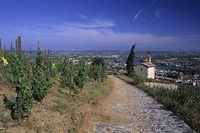 than they were 20 years ago, but they remain under-appreciated by almost any standard. They also remain under-priced in my opinion, though that means different things in the northern and southern portions of the Rhône. than they were 20 years ago, but they remain under-appreciated by almost any standard. They also remain under-priced in my opinion, though that means different things in the northern and southern portions of the Rhône.
In the south, prestige cuvées of Châteauneuf du Pape (and, to a lesser degree, Gigondas) have become quite expensive, but standard-issue wines remain quite affordable by comparison to their qualitative equivalents from Bordeaux. Even more attractive values can be had from appellations such as Vacqueras and Rasteau, and there are lots of excellent bottlings of Côtes du Rhône that offer amazing quality at prices in the mid-teens.
Wines from the northern Rhône are notably more expensive than their brethren to the south, but they are also much, much rarer, as the AOCs in the north produce less than one-tenth of the AOCs in the south. Appellations such as Côte-Rôtie, Cornas and Condrieu will eventually be priced as high as tiny Bordeaux appellations such as Pomerol (mark my words), and savvy consumers and collectors would do very well to buy these wines from strong vintages now, before the party is over once and for all.
And guess what? Two terrific vintages are headed our way, with early wines from 2009 already on hand in many cities, and scores of really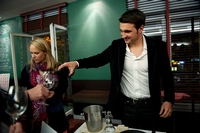 amazing wines from 2010 due to arrive before long. I recently sat down to talk and taste with Bastien Tardieu, a 27 year-old wunderkind with trained at Montpellier who helps guide the superb Rhône negociant firm of Tardieu-Laurent, who offered reflections on the 2009 and 2010 vintages. amazing wines from 2010 due to arrive before long. I recently sat down to talk and taste with Bastien Tardieu, a 27 year-old wunderkind with trained at Montpellier who helps guide the superb Rhône negociant firm of Tardieu-Laurent, who offered reflections on the 2009 and 2010 vintages.
Tardieu spoke of the 2009 vintage as quite good in the south but wonderful in the north, where growing conditions were akin to 1999, which produced scores of terrific wines. The south experienced some difficulties due to heat, which affected the vines during the summer and into September. Some fermentations stopped and re-started, but the wines are marked by ample sugars and full phenolic ripeness, and will be generous and full of flavor. In the north, the relatively high temperatures made for rich, opulent whites, but they may be a bit lacking in freshness and aromatic expressiveness. The reds, however, are, again, “wonderful,” with balanced alcohol and lively, layered flavors.
He spoke with even more enthusiasm for 2010, which immediately drew descriptions as a “great, outstanding vintage.” Perhaps a bit better in the south, the wines of the entire region are marked by exceptional acidity (a characteristic also shown by 2010 wines from Bordeaux). They will likely show great capacity for ageing as a result, but with deep color, fine tannins, and “perfect balance,” many of them will be very enjoyable while young.
If the prospect of these wines is whetting your appetite before the wines are actually here to wet your whistle, Tardieu-Laurent has some exceptional wines already for sale here in the USA, including Côtes du Rhône Blanc 2008 ($30, 90 points); St. Peray 2008 ($38, 91 points); Châteauneuf du Pape Blanc Vieilles Vignes 2008 ($83, 93 points); Vacqueras Vieilles Vignes 2008 ($42, 91 points); Crozes-Hermitage Vieilles Vignes 2008 ($44, 90 points); Cornas “Coteaux Rouge” 2007, $69, 93 points), and Châteauneuf du Pape Rouge “Cuvée Speciale” 2007 ($88, 95 points).
I’ll have full reviews of these wines in next week’s issue of WRO, and will follow those up with profiles of the Rhône’s other negociant powerhouses, Chapoutier and Guigal. But for now, please don’t spend your wine budget savings on newly-arrived Bordeaux without considering the river of delicious Rhônes that’s flowing in our direction!
Posted by Michael Franz at 7:43 AM
|
|
April 26, 2011
Jess Jackson, who lost his battle with cancer last week, sure could pick winners. In the last decade of his life, when he devoted much of his considerable energy to thoroughbred racing, his Stonestreet Farm saddled champion after champion. The roll call included Curlin, both 2007 and 2008’s horse of the year, and Rachel Alexandra, winner of that same award in 2009. (Since the two have since been bred with each other, another equine superstar may soon be on the way.) Racing, however, was only one of Jackson’s winning ventures. First in law, then real estate and business investing, and eventually wine, he made a fortune by spotting emerging trends and backing victors. 2007 and 2008’s horse of the year, and Rachel Alexandra, winner of that same award in 2009. (Since the two have since been bred with each other, another equine superstar may soon be on the way.) Racing, however, was only one of Jackson’s winning ventures. First in law, then real estate and business investing, and eventually wine, he made a fortune by spotting emerging trends and backing victors.
While Jackson enjoyed success in all these fields, his accomplishments in the world of wine were surely the most significant. His Kendall-Jackson brand did more than win its sales races. More than any other single label, it changed how millions of Americans thought about wine in general, and so played a leading role in the United States becoming what it is today--the largest wine-consuming market in the world.
Jackson got into the wine business in 1974, when he converted an eighty-acre pear and walnut orchard near Lakeport, California into a vineyard. Like many others at the time, he saw that wine was finding a new audience in a country that long had shunned it, and wanted to get into the game. Unlike most of the era’s other wine entrepreneurs, however, he focused almost exclusively on wine made for casual, everyday drinking. In 1982, he produced the first vintage of Vintner’s Reserve Chardonnay. Priced at $4.50, it was more expensive than jug “chablis,” but significantly less costly than all the Napa Valley wines then aiming to compete directly with French Bordeaux and Burgundy.
Vintner’s Reserve Chardonnay became a huge hit, its popularity coming in part from its never even trying to echo a foreign model. Instead, this 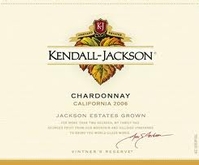 new wine pioneered a slightly off-dry, tropical-fruit style that millions of people unfamiliar with European crus and cuvées found easy to enjoy. (Paradoxically enough, that style has gone on to be emulated by vintners all over the world, including many in France.) Jackson used grapes from his own vineyard, but as sales grew, he purchased more and more fruit from throughout California. Industry insiders told him that the market demanded a more precise geographical designation. He ignored them. As he told me when I interviewed him almost twenty years later, he recognized that the new generation of American wine drinkers was going to think of wine first and foremost in varietal terms. All that mattered was that the label said “Chardonnay,” and that the wine in the bottle tasted good. “My goal,” he said, “was to broaden the wine-drinking public.” new wine pioneered a slightly off-dry, tropical-fruit style that millions of people unfamiliar with European crus and cuvées found easy to enjoy. (Paradoxically enough, that style has gone on to be emulated by vintners all over the world, including many in France.) Jackson used grapes from his own vineyard, but as sales grew, he purchased more and more fruit from throughout California. Industry insiders told him that the market demanded a more precise geographical designation. He ignored them. As he told me when I interviewed him almost twenty years later, he recognized that the new generation of American wine drinkers was going to think of wine first and foremost in varietal terms. All that mattered was that the label said “Chardonnay,” and that the wine in the bottle tasted good. “My goal,” he said, “was to broaden the wine-drinking public.”
In later years, Jackson turned his attention to super-premium wines as well. He recognized that consumer tastes were shifting. He never abandoned, however, his commitment to well-made, reasonably-priced wine sold under a label that people could trust. After all, he knew that Vintner’s Reserve, which came to include a bevy of different varietals, was his biggest winner.
Posted by Paul Lukacs at 6:21 AM
|
|
Posted by Paul Lukacs at 6:18 AM
|
|
April 25, 2011
Considering its relatively small population (about 30,000), and considering how far it is from any major metropolitan center (about 4 hours to get to Seattle or Portland), it strikes me that Walla Walla has attracted a disproportionate number of French vignerons plying their trade in this bucolic corner of Washington state. They hail from almost  every winemaking region of France, including Provence (Virginie Bourgue), Burgundy (Eve-Marie Gilla) and Champagne (Christophe Baron). And then there’s Serge Laville, a native of--wait, Paris? Paris is no viticultural region! But not to worry, Serge had enough hands-on experience as a youngster working in his grandfather’s Côtes du Rhône winery to qualify as a véritable onologue français, a true French winemaker. every winemaking region of France, including Provence (Virginie Bourgue), Burgundy (Eve-Marie Gilla) and Champagne (Christophe Baron). And then there’s Serge Laville, a native of--wait, Paris? Paris is no viticultural region! But not to worry, Serge had enough hands-on experience as a youngster working in his grandfather’s Côtes du Rhône winery to qualify as a véritable onologue français, a true French winemaker.
In 2000 Serge Laville visited the United States. He came as a tourist, travelling around the country with backpack and camera, but when he 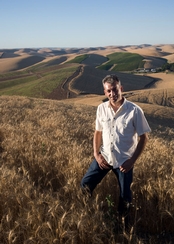 reached Walla Walla a chance meeting with Spring Valley Vineyard’s founding winemaker, Devin Corkrum Derby changed the course of his life. Serge fell in love with the region, the wines, and the woman who would ultimately become his wife. He started working with Devin at Spring Valley (the site had been homesteaded by Devin’s ancestor, Uriah Corkrum, in 1866). Serge’s first Spring Valley harvest was in 2002, then, in 2004, after Devin Derby’s untimely death, he took over the winemaking responsibilities. In 2005, Ste. Michelle Wine Estates leased the vineyard and winery and purchased the Spring Valley Vineyard wine brand from the Derby family. The wines, under Serge’s care, continue to be superb, winning raves and high scores from significant wine reviewers everywhere (at Wine Review Online Michael Apstein awarded 2003 “Uriah Red” 93 points). reached Walla Walla a chance meeting with Spring Valley Vineyard’s founding winemaker, Devin Corkrum Derby changed the course of his life. Serge fell in love with the region, the wines, and the woman who would ultimately become his wife. He started working with Devin at Spring Valley (the site had been homesteaded by Devin’s ancestor, Uriah Corkrum, in 1866). Serge’s first Spring Valley harvest was in 2002, then, in 2004, after Devin Derby’s untimely death, he took over the winemaking responsibilities. In 2005, Ste. Michelle Wine Estates leased the vineyard and winery and purchased the Spring Valley Vineyard wine brand from the Derby family. The wines, under Serge’s care, continue to be superb, winning raves and high scores from significant wine reviewers everywhere (at Wine Review Online Michael Apstein awarded 2003 “Uriah Red” 93 points).
I recently had occasion to attend a vertical tasting of Spring Valley’s “Uriah” series, a Merlot-based blend named for Uriah Corkrum, who first homesteaded the land that became Spring Valley. The 40 acre Spring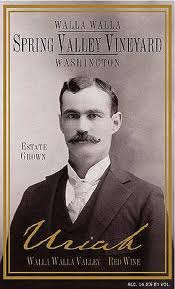 Valley Vineyard, at an elevation of 1,200 to 1,500 feet), has vine-friendly clay and volcanic soils. The temperatures at this altitude tend to be cooler during the growing season, which helps the grapes to develop zingy acidity and also allows them to ripen on the vine longer than other places. “When the rest of Walla Walla has finished harvesting is usually when Spring Valley starts picking,” says Serge Laville. Valley Vineyard, at an elevation of 1,200 to 1,500 feet), has vine-friendly clay and volcanic soils. The temperatures at this altitude tend to be cooler during the growing season, which helps the grapes to develop zingy acidity and also allows them to ripen on the vine longer than other places. “When the rest of Walla Walla has finished harvesting is usually when Spring Valley starts picking,” says Serge Laville.
Spring Valley’s first vintage, 1999, still shows remarkable amounts of fresh fruit, but it lacks complexity and has dulled somewhat over the years. Or perhaps it never did truly shine, and has evolved into greatness over the years as the vines matured and the winemaking gained expertise. 2003 was a gorgeous vintage. The wine, a blend of 77% Merlot, 22% Cabernet Franc and 2% Petit Verdot, is loaded with delectable dark fruit, hints of chocolate, and a trail of luscious, soft tannins. The superlative 2004 is the only one that includes Cabernet Sauvignon in the blend (about 5%), which kicks the power up a notch and adds firmness to the tannins without in any way sublimating the wine’s structure or inherent fruit-laced deliciousness.
If I had to pick a favorite vintage it might be the 2006, possibly because of the intensity of its fruity, floral fragrance. It includes 6% Malbec as well as Merlot, Cab Franc and Petit Verdot. 2006 was an almost perfect growing season, dominated by a hot, dry summer and a long, mild ripening period that lasted all the way into October, and resulted in small berries loaded with sweet, condensed flavors. The 2007 Uriah seems almost too young to really evaluate, though its good structure and balance are obvious, with freshness and elegance its most significant features right now. Each of the Uriah wines costs about $50. Only a few thousand cases are made each year, so tracking them down is a bit of a treasure hunt. The bottom line: Walla Walla oui! oui!
Posted by Marguerite Thomas at 8:34 AM
|
|
April 20, 2011
In my 18 years of writing about wine, the best question ever put to me remains one sent by a Washington Post reader about 13 years ago: “What is the best wine in the world that I’ve never heard of?”
My answer at that point was Albariño from the Rias Baixas region in the northwestern corner of Spain. These wonderful whites were still very rare back then, even in a big, open market like Washington, D.C. Today, however, I could jump in my car and be back before long with a trunk-full of different Albariños, which points to two things: First, Spain has really arrived as the major commercial power everyone knew it could be for decades prior to its actual emergence around the turn of the millennium. And second, I need a new answer to my favorite question.
My new answer shares some things with my former one. I’m every bit as clear and convinced about this one, and the wine is once again a varietal offering from the northwest of Spain. That’s where the similarities end, however, as my new choice is a red, namely, Mencia from Bierzo.
Your response to this might well be, “What, from where?” Since bottlings of Mencia from Bierzo are still just starting to trickle into the U.S. market, this wouldn’t be surprising. But trust me: These wines aren’t mere curiosities, but, rather, real contenders for greatness on the world stage, and the best renditions already rival top offerings from Rioja, Priorat, and Ribera del Duero for positions at the very top of Spain’s quality pyramid.
At this point you might well wonder, “If these wines are so terrific, why 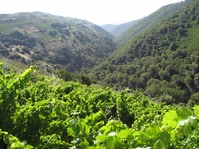 do they remain so obscure?” There are several answers to this. First, Bierzo is an inland region that isn’t geographically geared for export like, say, Bordeaux. Second, the region is phenomenally rugged in topography and relatively remote from major transportation arteries, so most of the vineyards were devoted to wine made for local consumption until recently. Third, the rather isolated setting of the region hampered economic development, and as many other parts of Spain boomed in the two decades between 1998 and 2008, the area around Bierzo became something of a commercial backwater, and many of the steepest and best vineyards were actually abandoned. do they remain so obscure?” There are several answers to this. First, Bierzo is an inland region that isn’t geographically geared for export like, say, Bordeaux. Second, the region is phenomenally rugged in topography and relatively remote from major transportation arteries, so most of the vineyards were devoted to wine made for local consumption until recently. Third, the rather isolated setting of the region hampered economic development, and as many other parts of Spain boomed in the two decades between 1998 and 2008, the area around Bierzo became something of a commercial backwater, and many of the steepest and best vineyards were actually abandoned.
Some villages in Bierzo remain so un-modernized even today that the place has a sort of twilight zone feel to it. For example, during my last visit to the area, a five-minute walk though a village included encounters with a communal washing fountain and bread oven as well as a flock of sheep and the Civic Oompah Band (or whatever the equivalent of a Spanish Oompah Band would be). This made for a delightful Monday morning, as you can see from the expression of my WRO colleague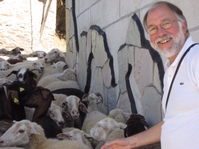 Michael Apstein, but it is not quite what one associates with places like Napa or Bordeaux. If a picture is really worth a thousand words, I need not say more about why Mencia and Bierzo aren’t yet household words in export markets. Michael Apstein, but it is not quite what one associates with places like Napa or Bordeaux. If a picture is really worth a thousand words, I need not say more about why Mencia and Bierzo aren’t yet household words in export markets.
But let us not forget: Wine is first and foremost an agricultural product rather than a manufactured good, and if the grape and the ground found in a place are both exceptional, one can make incredible wine even in a commercial twilight zone.
There’s no question that Bierzo can make incredible wine from Mencia, as you’ll discover if you try a wine like Paixar or the Las Lamas or La Faraona from Descendientes de J. Palacios. A top Mencia from Bierzo 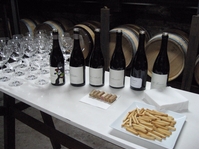 can combine the minerality of great Bordeaux with the acidity of Barolo with the supple feel of Brunello and pack all of that into a wine with the versatile, relatively modest weight of a great Chinon. The coexistence of these qualities in a single wine is uncanny, and yet the best renditions seem pure and natural, which makes the total package somehow even more uncanny. can combine the minerality of great Bordeaux with the acidity of Barolo with the supple feel of Brunello and pack all of that into a wine with the versatile, relatively modest weight of a great Chinon. The coexistence of these qualities in a single wine is uncanny, and yet the best renditions seem pure and natural, which makes the total package somehow even more uncanny.
Today there are enough renditions of Mencia from Bierzo available outside Spain to really show how good--and how distinctive--it can be. This is exactly what I’ll be doing in New York a week from today, when I’ll be conducting a seminar on wines from Bierzo for press and the wine trade between 10:30 and noon at La Fonda del Sol in Manhattan.
If you are located in New York but can’t make it to the seminar (which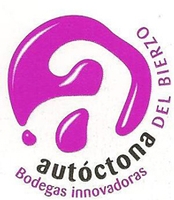 I'll conduct on behalf of Autóctona del Bierzo, a consortium of innovative producers) it will be followed by a tasting showroom and tapas reception at the same site (Vanderbilt Avenue at 44th Street) from noon until 4:30 p.m. For information, go to the website for The Connected Table or call 212-620-7027. If you live elsewhere, not to worry, as I’ll be back with a full column on Bierzo and its leading bottlings of Mencia before long here on WRO. I'll conduct on behalf of Autóctona del Bierzo, a consortium of innovative producers) it will be followed by a tasting showroom and tapas reception at the same site (Vanderbilt Avenue at 44th Street) from noon until 4:30 p.m. For information, go to the website for The Connected Table or call 212-620-7027. If you live elsewhere, not to worry, as I’ll be back with a full column on Bierzo and its leading bottlings of Mencia before long here on WRO.
Posted by Michael Franz at 8:11 AM
|
|
April 19, 2011
For centuries, complexity has been the principal sign or marker distinguishing special from basic wines, what the French called vins fin from vins ordinaire. Other attributes--notably cleanliness--long separated sound wines from flawed wines, but experiencing a multiplicity of enticing aromas and flavors was what led people to judge certain wines superior.
Jancis Robinson put this notion well in her autobiographical 1997 book, Tasting Pleasure, when she noted that “there is more in every way in an incontrovertibly fine wine.” In turn, a love of and desire for that “more” can attract people to wine in a way that they are never attracted to any other sort of food or drink. In Robinson’s words, it can make certain wines reach “not just your throat and nose but your brain, your heart, and occasionally your soul too.” Put another way, a wine’s complexity can render drinking it a transformative experience.
“More” still enthralls wine drinkers, but these days it often seems to be a matter of concentration instead of complexity. These certainly are not antithetical attributes. Some of the best wines I’ve ever tasted have evidenced both. But many other equally compelling ones have not. These have been complex but delicate, evidencing intricacy rather than intensity, so subtlety rather than strength. And I’ve definitely drank many concentrated wines that tasted simple and monolithic, their power overwhelming any possibility of nuance. No matter--concentration, not complexity, is what a great many people, winemakers and wine drinkers alike, think of as “more” these days.
Why have concentrated wines become so in vogue? I can think of many reasons, everything from the influence exercised by certain influential wine critics to shifts in how millions of people drink wine, treating it more as a cocktail than a food beverage. The most important reasons, however, are probably technological. Modern science has led to advances in both vineyards and wineries that make producing concentrated wines much easier than ever before. Only a generation ago, when a great many of the world’s wines tasted disappointingly thin and weak, greater concentration was a winemaker’s dream. Today, those wines (which also tasted undeniably simple) are relics of times thankfully gone by. Most contemporary wines, regardless of grape variety or geographic origin, display a sufficient intensity of aroma and flavor so as to prove at least satisfying.
Yet satisfying is not the same as compelling, and the fact that something is technically possible to achieve does not necessarily mean that it is worth achieving--or at least worth achieving all the time. Intensity in wine can prove impressive but one-dimensional. In today’s age of globalization, wine is very much like fashion, and I strongly suspect that the current craze for concentration eventually will ebb. Why? Because I remain convinced that concentration cannot--by itself--enable a wine to touch one’s heart and soul, while I know that complexity can.
Posted by Paul Lukacs at 6:56 AM
|
|
April 17, 2011
That bottle of wine you just opened may hail from the Napa Valley (or Rioja or Chianti Classico) but it’s increasingly possible that an outside influence contributed as much to the wine’s character as did the locally grown grapes and regional terroir. For with the proliferation of flying vintner-consultants, foreign investment, and young winery interns bopping from one hemisphere to the next, the exchange of knowledge and wine-growing philosophies is having an impact on wine everywhere.
I recently tasted an impressive wine that vividly illustrates this growing phenomenon. Called “Vertice,” the wine in question is a product of Viña Ventisquera, in Chile’s Maipo Valley. Vertice is a joint venture between Ventisquera’s chief winemaker, Felipe Tosso--a Chilean of Italian descent--and the illustrious Australian vintner John Duval who was, from 1986 to 2002, chief winemaker at Penfolds. For the past eight years this dynamic duo has worked in tandem on Vertice, creating three vintages thus far, with Duval flying in annually for the weeks-long critical periods of tastings and blendings. The result of the partnership is what Duval has described as “four-handed wines,” with each man’s techniques and knowledge ultimately blending into a of Viña Ventisquera, in Chile’s Maipo Valley. Vertice is a joint venture between Ventisquera’s chief winemaker, Felipe Tosso--a Chilean of Italian descent--and the illustrious Australian vintner John Duval who was, from 1986 to 2002, chief winemaker at Penfolds. For the past eight years this dynamic duo has worked in tandem on Vertice, creating three vintages thus far, with Duval flying in annually for the weeks-long critical periods of tastings and blendings. The result of the partnership is what Duval has described as “four-handed wines,” with each man’s techniques and knowledge ultimately blending into a  harmonious whole. An intensely personal as well as professional bond clearly links the two vintners now. “It’s a unique relationship, with each of us bringing something vital to the blend,” says Tosso. The very choice of grapes--Syrah (a.k.a. Autralia’s Shiraz) and the Chilean flagship Carmenère--tells its own story. harmonious whole. An intensely personal as well as professional bond clearly links the two vintners now. “It’s a unique relationship, with each of us bringing something vital to the blend,” says Tosso. The very choice of grapes--Syrah (a.k.a. Autralia’s Shiraz) and the Chilean flagship Carmenère--tells its own story.
Vertice 2007, the dark, rich and beautifully balanced current release, astounds the palate with its fiery passion and a plenitude of silky tannins. In addition to the forthright appeal of fruit expertly grown in sunny climates, Vertice also shows off the kind of elegance and sophistication born of scrupulous winemaking. There is no doubt that a portion of this wine’s personality represents the twining of two minds and hearts from two different sides of the world, in what Duval describes as a “joining of cultures, philosophies and passion for wine.” With only about 1,000 cases made, this is a rare, limited edition wine that will obviously be difficult to find in retail markets. Like many rarities it’s worth the search. Unlike most such rarities, at $40 a bottle it’s supremely affordable. As usual, the Bard sums it up best: “O wonder! How many goodly creatures are there here! How beauteous mankind is! O brave new world That has such people in’t!”
Posted by Marguerite Thomas at 9:23 AM
|
|
April 6, 2011
As one of the volunteers peered down the line of Platinum Award winning wines immediately after the conclusion of last weekend’s San Diego International Wine Competition, I heard her remark, “Four wines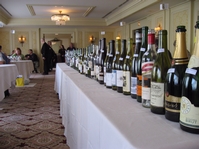 from Benziger…wow, are they lucky!” from Benziger…wow, are they lucky!”
In a rare show of restraint, I bit my tongue at the time. What I really wanted to say, however, was, “Lucky? If you win one Platinum Award, maybe that’s lucky. But when you win four of them, that’s kicking ass!”
Pardon my French, but nothing less emphatic will do justice to the accomplishment, which is nothing short of astonishing when you crunch the numbers.
A total of 1,666 wines were entered in the SDIWC, and only 66 of them won Platinum Awards, which is less than 4%. To have four panels--tasting blind--put four different wines forward with Platinum Awards for the Sweepstakes Round is truly remarkable, especially when you consider that the four were made from four different grape varieties.
Here are my reviews of the four wines:
Benziger Family Winery, Carneros (California) Sangiacomo 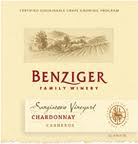 Vineyard Chardonnay 2008 ($20): The balance of fruit and oak in the wine is essentially perfect, as the light notes of spices and toast neither overwhelm nor get lost underneath the fruit, which shows exceptionally pure notes of ripe pear and peach. The balance between--and integration of--acidity and fruitiness could hardly be better, and the wine’s overall character is completely convincing. Bloody impressive juice, and at a very attractive price. 93 Vineyard Chardonnay 2008 ($20): The balance of fruit and oak in the wine is essentially perfect, as the light notes of spices and toast neither overwhelm nor get lost underneath the fruit, which shows exceptionally pure notes of ripe pear and peach. The balance between--and integration of--acidity and fruitiness could hardly be better, and the wine’s overall character is completely convincing. Bloody impressive juice, and at a very attractive price. 93
Benziger Family Winery, Russian River Valley (Sonoma County, California) Pinot Noir 2008 ($28): Striking for its delicacy and restraint in the context of California Pinot Noir, this wine is pretty rather than powerful, with light color and weight. The aromas are nevertheless quite expressive, showing notes of wild strawberry and red cherry, and the flavors mirror the aromas in a way that makes the wine seem admirably seamless and natural. The oak is extremely subtle, and there’s lots of fresh acidity to brighten the finish. 92
Benziger Family Winery, Sonoma County (California) Cabernet Sauvignon 2007 ($20): Pure, seamlessly integrated, natural and thoroughly delicious, this is a very well made and stylish Cabernet that must have been based upon very fine fruit. Blackberry and cassis fruit notes show just the faintest tinge of oak, with a subtle cocoa powder note and a bit of spice also showing around the edges. There’s enough tannin to counterbalance the sweetness of the fruit. A very good buy for $30, and a steal at $20. 92
Benziger Family Winery, Sonoma County (California) Merlot 2007 ($19): A medium-bodied Merlot that offers lots of aroma and flavor in a moderately-sized package, this wine is at once stylish and generous. Pure fruit notes recalling black plums and red berries are the prime attraction, with subtle backnotes of espresso beans, spiced meat and toast. Notable tannins frame and firm the wine, but they are quite fine in grain, and don’t have the effect of drying the finish. Very well made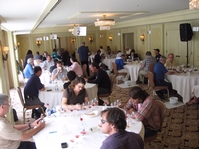 in a style that will prove highly versatile at the table. 90 in a style that will prove highly versatile at the table. 90
As a last word, I’ve been judging wine competitions around the world for nearly 20 years, and I cannot remember a single producer’s wines achieving such prominence at the very top of an event. Hats off to everyone at Benziger…and while you are tipping your cap, I’ll be getting a head start toward the wine shop….
Posted by Michael Franz at 12:55 PM
|
|
 |
|